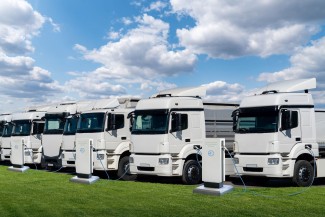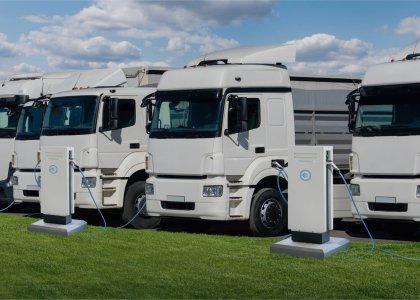Electric trucks are vital for decarbonizing transportation, but the grid needs to be adapted to support their significant charging needs. A new white paper explores how states and utilities can prepare for electric truck fleets and profiles leading efforts.
Electric trucks are growing in availability and sales, with momentum building steadily, particularly for categories such as delivery vans and transit and school buses. This is good news for the climate—buses and freight trucks account for about 28% of all vehicles’ greenhouse gas emissions in the United States—but a challenge for the grid. Charging truck fleets will require significant power, in some cases equivalent to the needs of a large factory, and local substations and distribution feeders will in many cases need to be upgraded to handle these loads.
A few utilities and states are starting to plan for these loads, but most are not. These challenges are the subject of a new white paper released by ACEEE today. We find an urgent need for more grid planning and identify leading initiatives that can serve as models.
Electric trucks’ substantial electricity demand will require updates to grid infrastructure
Discussions with electric truck manufacturers indicate that inadequate on-site power to charge vehicles is a major barrier to fleet electrification. Power for trucks and buses is generally more of an issue than for cars because they have larger batteries and are often parts of fleets with many vehicles that charge at the same location and at the same time. Depending on the number and size of chargers, fleet charging can require several megawatts of power, with loads up to 40 megawatts in some applications (similar to many large factories). One recent estimate finds that California utilities will need to invest $50 billion from 2025 to 2035 for distribution system upgrades, including feeders, transformer banks, and substations, to handle growing loads from vehicle and building electrification.
Electric utilities and utility regulators should start planning for electric fleet impacts now to help ensure that they can make grid improvements steadily as these fleets grow. We recommend that grid planning for fleets happen in parallel so that grid upgrades are in place when needed. If grid upgrades are delayed, vehicle purchases will be slowed. In locations where utilities are not yet planning for fleet loads, regulators should push them to start.
Starting to plan now is essential, especially where new substations are needed. New substations typically take at least 2–4 years for planning and construction and can cost $4 million to $35 million. While current distribution plans typically look 5 years ahead, given the large infrastructure needs for electrification, longer-term planning will be important to establishing budgets and grid plans ahead of need. We recommend that electric utilities and utility regulators develop plans looking ahead 10–20 years and update them regularly to reflect changing conditions and trends, ideally every 1–2 years.
Leading states and utilities can provide models for how to support and plan for electric fleets
A handful of states and utilities have programs to assist fleets with planning and installing chargers. Many of these states have begun efforts to plan for providing power for these loads. California utilities are leaders in programs for fleets, and Massachusetts and New York State have promising processes underway to proactively address grid planning. For example, Massachusetts utilities are undertaking initial fleet assistance programs and have recently begun a grid modernization process overseen by a new Grid Modernization Council. Earlier this month, utilities filed their grid plans for review by the Council and ultimately for approval by the state regulatory commission.
In New York, the Public Service Commission has opened a medium-/heavy-duty vehicle docket to look at both programs and the need to plan more proactively for grid transportation grid needs, rather than the current practice of “just in time” planning. New York utilities filed joint comments making two major suggestions: (1) that “compelling incentives” be offered through a full-scale make-ready program to accelerate the current limited market progress; and (2) that a proactive grid planning process be put in place “so utilities are ready to serve customer electrification loads in advance of requests for customer capacity.” Additional case studies in today’s white paper discuss efforts in Illinois, Colorado, Minnesota, and Oregon.
These leading states and utilities can provide examples and insights for their peers interested in supporting electric fleets and managing their grid impacts. Given growing momentum on fleet electrification, the time to begin these efforts is now.



